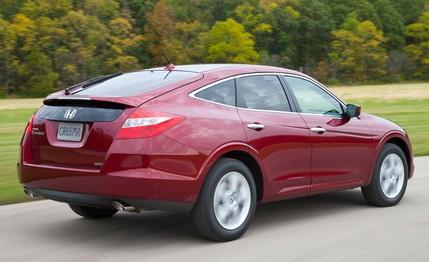 Short Take Road Test
Short Take Road Test

Honda pumped up the Accord into large-car territory in 2008, once again improving the perennial 10Bester’s refinement and packaging without diminishing its dynamic excellence. Now the Accord Crosstour wagon joins the lineup for 2010, demonstrating that Honda is willing to sacrifice that trait, along with the sedan’s already questionable looks, for greater functionality.
Accord-Plus Package
Sharing the Accord’s chassis, as well as its optional 271-hp, 3.5-liter V-6 and five-speed automatic—a four-cylinder isn’t offered—the Crosstour is Honda’s answer to vehicles such as the Toyota Venza and the Subaru Outback, which offer all-wheel drive and squeeze the better part of a crossover’s five-door utility into a lower-profile wrapper.
It certainly looks like an Accord inside, mostly because it shares the same instrument panel. But the Crosstour is far more spacious, with 26 cubic feet of cargo room behind the second row—the sedan’s trunk holds 14 cubes—and the area is nicely finished with loop-pile carpet, release handles for the rear seats (cargo space expands to 51 cubic feet), and a removable storage bin under the floor that could double as an ice chest for tailgating.
The narrow, split-glass hatch, however, impedes rear visibility and must be manually opened and closed. Its canted design combined with the sloping roof also limits interior volume, with the more squared-off Venza and Outback both offering 34 cubes behind the second row and about 70 with the rear chairs stowed. Rear-seat headroom is adequate for six-plus footers.
Accord-Minus Result
Despite the added, albeit compromised, utility, the exterior shape that allows the extra room is difficult to swallow. The styling is bulbous and frumpy and makes the Crosstour look like a supersized Insight hybrid on stilts. And it’s not light; about 300 pounds more than a V-6 Accord to start and an additional couple hundred pounds for all-wheel drive, which overtaxes the CR-V–size brakes under heavy use.
With steering that’s not as crisp, as well as a loftier perch and larger tires on 17- or 18-inch wheels, the Crosstour is no Accord sedan on the road. But it is not completely sensory depriving like most crossovers. That’s because it is a wagon, and it retains most of the sedan’s overall composure.
Although the five-speed automatic lacks the extra cog of the Venza and the manumatic-shifting mode of nearly everything else, it’s been programmed to hang on to gears longer when the stability control system's wheel-speed sensors detect you’re pushing the vehicle through corners, or when going up or down steep grades. While the Crosstour’s 1500-pound tow rating provides it with enough utility to haul a couple of jet skis, its six inches of ground clearance mean it won’t get over much more than a small snow drift.
We recorded a 7.2-second 0–60 dash and a 15.4-second quarter-mile run at 92 mph with the Honda, which are respectable numbers but only slightly quicker than those of the lighter Outback with the optional 256-hp, 3.6-liter flat-six (7.4 and 15.7 seconds, respectively). A Venza with the 3.5-liter V-6, all-wheel drive, and an additional 127 pounds to lug around, however, is more than a half-second quicker in both measures and can stop from 70 mph in 18 fewer feet (169 versus the Honda’s 187).
Competitive But Compromised
Honda expects to sell about 40,000 Crosstours annually to empty-nesters who are averse to bulky crossovers yet still need some versatility. Billed as the premium model in the Accord range, prices start at $30,380 for front-drivers—about three grand above a V-6 Accord sedan—and approach $37,000 for one like our test car, with all-wheel drive and navigation. Comparable Venzas and Outbacks both top out similarly, but also offer four-cylinder options for thousands less, and the Subaru includes standard all-wheel drive.
Fuel economy just one or two mpg less than an Accord V-6’s should help with Crosstour sales—we averaged 21 mpg with our tester, which has a city/highway rating of 17/25—but a conventional Accord wagon likely would have served the same role. And would have looked better doing it.